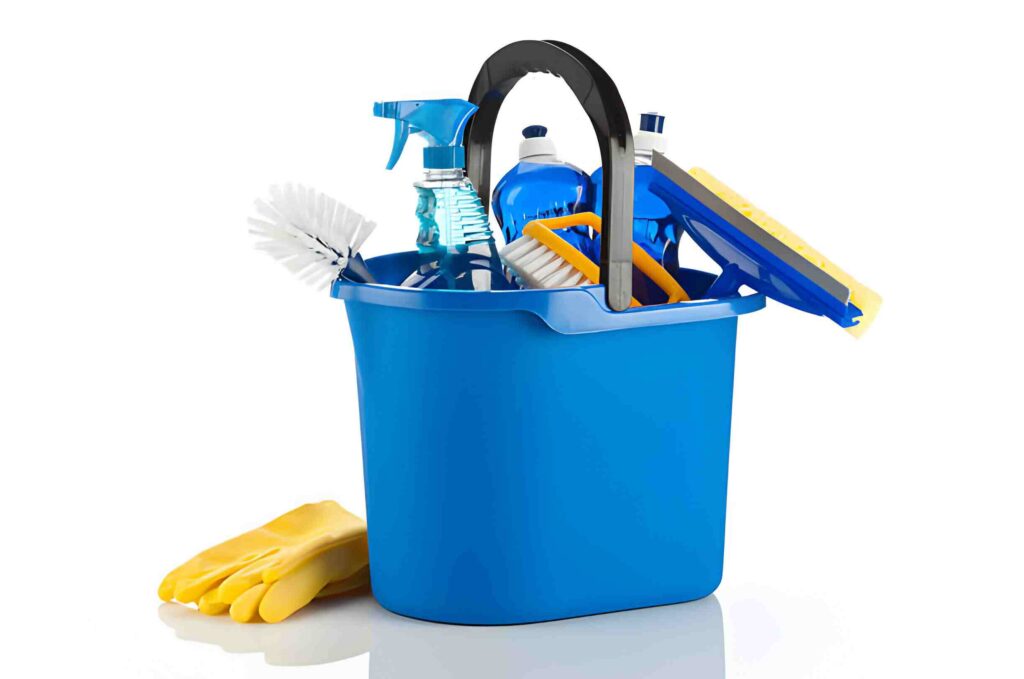
Welcome to the enlightening journey into the world of Eco-Friendly Commercial Cleaning Products, where the commitment to cleanliness meets the power of sustainability in the workplace. In this comprehensive guide, we will unravel the importance of choosing eco-friendly cleaning solutions and their profound impact on not only the cleanliness of your office but also the well-being of our planet. From the ingredients that make these products green to the benefits they bring to your workspace, each section will illuminate the path towards a cleaner and more sustainable workplace environment.
See also our product on 10 Homemade Cleaning Products You Can Make at Home and How to Make Them
The Essence of Eco-Friendly Cleaning
Plant-Based Formulas
Explore the wonders of plant-based cleaning formulas. These products derive their cleaning power from natural sources, such as citrus, herbs, and essential oils, providing an effective and environmentally friendly alternative to traditional cleaning agents.
Biodegradability Matters
Dive into the concept of biodegradability. Eco-friendly cleaning products break down naturally, minimizing their impact on the environment and preventing the accumulation of harmful residues in water sources and ecosystems.
Reduced Carbon Footprint
Discover how choosing eco-friendly products contributes to a reduced carbon footprint. From manufacturing processes to transportation, these products are often designed with sustainability in mind, leading to lower overall greenhouse gas emissions.
Packaging Innovation
Explore the world of innovative packaging. Many eco-friendly cleaning products come in recyclable or biodegradable packaging, reducing the environmental impact of waste and encouraging responsible disposal practices.
Certifications and Labels
Understand the significance of certifications and labels. Look out for reputable eco-friendly certifications that guarantee the sustainability of the products, ensuring that your cleaning choices align with the highest environmental standards.
Advantages of Eco-Friendly Cleaning Products
1. Indoor Air Quality Improvement
Learn how eco-friendly products contribute to better indoor air quality. Free from harsh chemicals, these cleaning solutions help create a healthier workspace by reducing the presence of volatile organic compounds (VOCs) in the air.
2. Safe for Users
Delve into the safety aspect. Eco-friendly cleaning products prioritize the well-being of users by avoiding harmful chemicals. This not only protects cleaning staff but also ensures a safer environment for everyone in the workplace.
3. Minimal Environmental Impact
Explore the minimal environmental impact of eco-friendly cleaning. From water sources to soil, these products are designed to leave a smaller ecological footprint, promoting a more sustainable and balanced ecosystem.
4. Long-Term Cost Savings
Understand the economic benefits. While eco-friendly products may seem initially pricier, their long-term advantages include cost savings on health-related issues, regulatory compliance, and a positive impact on corporate social responsibility.
5. Employee Morale Boost
Recognize the positive impact on employee morale. Knowing that the workplace prioritizes sustainability can boost morale and engagement among employees, creating a sense of pride and shared responsibility for a greener future.
See also our post on The Art of Green Cleaning: A Comprehensive Guide to Eco-Friendly Products
Common Eco-Friendly Cleaning Ingredients
Citrus Extracts
Discover the cleaning power of citrus extracts. Lemons, oranges, and grapefruits contribute to effective degreasers and stain removers, leaving a refreshing and natural scent behind.
Vinegar’s Versatility
Explore the versatility of vinegar. From windows to floors, vinegar is a potent eco-friendly cleaner known for its ability to cut through grease, eliminate odors, and act as an antibacterial agent.
Baking Soda Brilliance
Uncover the brilliance of baking soda. This humble ingredient serves as a gentle abrasive, deodorizer, and stain remover, making it a staple in eco-friendly cleaning solutions.
Essential Oils’ Efficacy
Appreciate the efficacy of essential oils. Tea tree, lavender, and eucalyptus oils possess antimicrobial properties, adding a pleasant fragrance while combating germs and bacteria.
Olive Oil’s Polishing Power
Embrace the polishing power of olive oil. When combined with lemon juice, olive oil becomes a natural and effective furniture polish, adding shine without the need for harmful chemicals.
Making the Transition to Eco-Friendly Cleaning
Assessing Current Cleaning Practices
Begin by assessing your current cleaning practices. Identify areas where eco-friendly alternatives can be introduced, considering factors such as types of surfaces, cleaning frequency, and product compatibility.
Employee Training and Awareness
Implement employee training programs. Ensure that cleaning staff are well-versed in the proper use of eco-friendly products, emphasizing the benefits of sustainability and the importance of responsible product disposal.
Gradual Integration
Consider a gradual integration approach. Start by introducing eco-friendly alternatives for specific cleaning tasks and gradually expand their use based on performance and employee feedback.
Collaborating with Suppliers
Engage with suppliers committed to sustainability. Collaborate with suppliers who share your eco-friendly goals, ensuring a steady supply of green cleaning products and supporting companies with a genuine dedication to the environment.
Monitoring and Evaluation
Establish monitoring and evaluation mechanisms. Regularly assess the performance of eco-friendly products, seeking feedback from cleaning staff and employees to make informed decisions on their continued use.
DIY Eco-Friendly Cleaning Solutions
All-Purpose Cleaner
Learn to make an all-purpose cleaner using simple ingredients like vinegar, water, and essential oils. This versatile solution is effective for countertops, surfaces, and even glass.
Natural Disinfectant Spray
Create a natural disinfectant spray using tea tree oil, vinegar, and water. This DIY solution is ideal for sanitizing surfaces without the use of harsh chemicals.
Grease-Cutting Degreaser
Make a grease-cutting degreaser with baking soda, castile soap, and lemon. Tackle stubborn grease and grime in kitchens or other work areas without resorting to harmful chemicals.
Freshening Air Spray
Craft a freshening air spray using essential oils and water. This natural air freshener helps eliminate odors and creates a pleasant and inviting atmosphere.
Stain Remover Paste
Prepare a stain remover paste using baking soda and water. This DIY paste is effective for tackling stains on carpets, upholstery, and other fabric surfaces.
See also our post on The Art of Green Cleaning: A Comprehensive Guide to Eco-Friendly Products
Overcoming Challenges in Eco-Friendly Cleaning
Initial Cost Concerns
Address concerns about initial costs. While eco-friendly products may seem more expensive initially, emphasize the long-term economic and environmental benefits to overcome resistance.
Performance Expectations
Manage performance expectations. Ensure that eco-friendly products are chosen based on their effectiveness for specific cleaning tasks, dispelling myths about their performance compared to traditional cleaners.
Employee Resistance
Tackle employee resistance through education. Provide comprehensive training on the benefits of eco-friendly cleaning, addressing concerns and emphasizing the positive impact on health and the environment.
Supplier Reliability
Choose reliable suppliers committed to sustainability. Establish partnerships with suppliers who consistently provide high-quality eco-friendly products, ensuring a steady and dependable supply.
Integration with Existing Protocols
Integrate eco-friendly practices with existing cleaning protocols. Make sustainability a seamless part of daily operations by aligning eco-friendly practices with established cleaning routines.
The Future of Eco-Friendly Cleaning in the Workplace
Technological Innovations
Explore technological innovations in eco-friendly cleaning. From advanced cleaning equipment to smart sensors, embrace technologies that enhance the efficiency and sustainability of workplace cleaning practices.
Evolving Regulations
Stay informed about evolving regulations. As governments and organizations increasingly prioritize sustainability, anticipate and adapt to changing regulations that may impact your choice of cleaning products.
Employee Engagement Programs
Implement employee engagement programs. Foster a sense of collective responsibility for sustainability by involving employees in eco-friendly initiatives, creating a workplace culture that values environmental consciousness.
Industry Collaboration for Sustainability
Encourage industry collaboration. Advocate for partnerships within the cleaning industry that promote sustainable practices, sharing knowledge and resources for the collective goal of a greener future.
Continuous Improvement Strategies
Embrace continuous improvement strategies. Regularly review and update eco-friendly cleaning practices, staying abreast of new developments and incorporating the latest advancements in sustainable cleaning solutions.
See also our post on Natural Solutions for Tough Cleaning Challenges: Stains, Mold, and More
Conclusion
Eco-Friendly Commercial Cleaning Products are the bright colors in the workplace cleaning mosaic that not only keep your office looking great but also add to the larger picture of environmental sustainability. This guide, which serves as a compass for those making the transition to green cleaning, has revealed the significance of selecting eco-friendly options and their many advantages.
From understanding the ingredients that make these products green to crafting DIY solutions and overcoming challenges, we have explored the details of sustainability in the workplace. As you embark on the path of eco-friendly cleaning, remember that each choice you make contributes to a cleaner, healthier, and more sustainable future for both your workplace and the planet. Let this guide be your beacon, guiding you towards a workplace where cleanliness is not just a duty but a testament to your commitment to a greener world.







